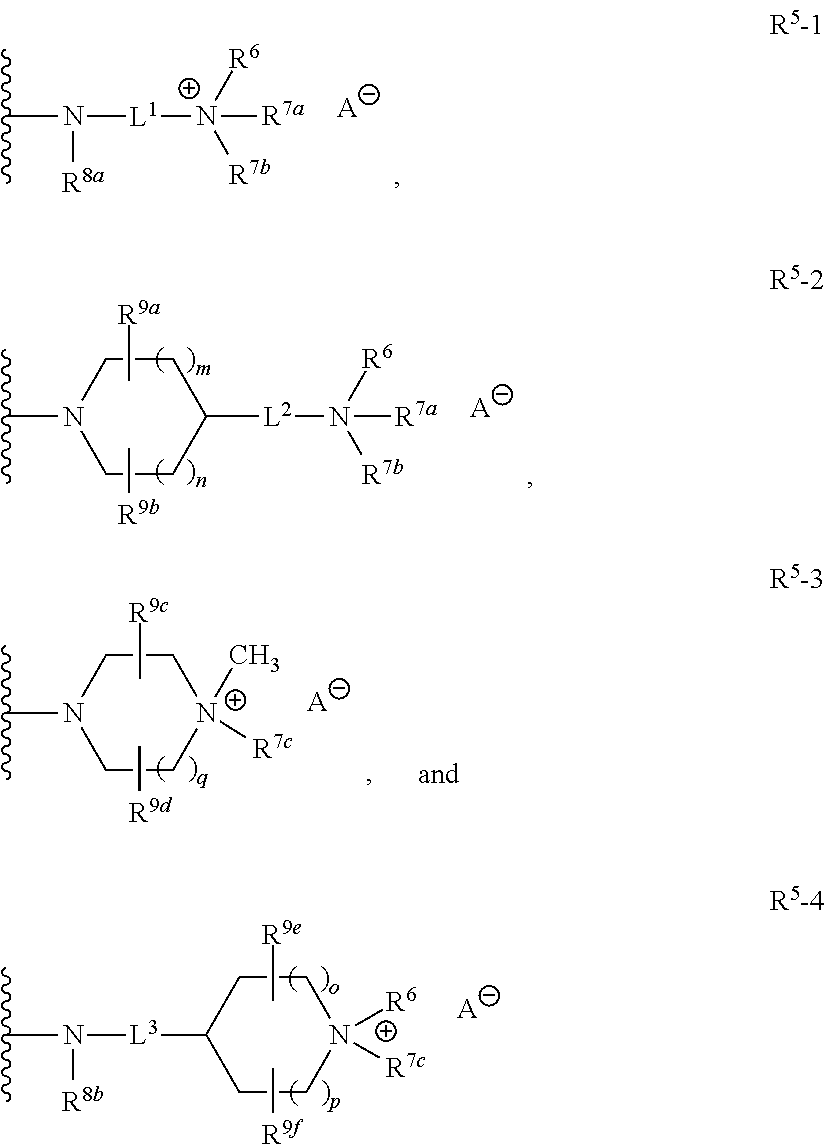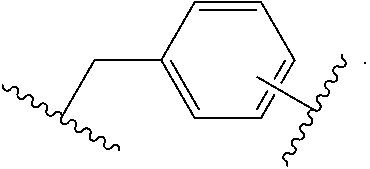Quaternized amines as sodium channel blockers
a technology of quaternized amines and sodium channel blockers, which is applied in the field of substituted pyridines and pyrimidine compounds, and can solve the problems of many undesirable side effects of the currently available treatments
- Summary
- Abstract
- Description
- Claims
- Application Information
AI Technical Summary
Benefits of technology
Problems solved by technology
Method used
Image
Examples
example 1
Preparation of 1-[2-({2-[4-(4-fluoro-phenoxy)-phenyl]-6-methyl-pyridine-4-carbonyl}-amino)-ethyl]-1-methyl-piperidinium
[0348]
Step 1: Synthesis of 1-(2-aminoethyl)-1-methylpiperidin-1-ium
[0349]
[0350]In a 100 mL round bottom flask, 2-(piperidin-1-yl)ethanamine (1 g, 7.8 mmol, Aldrich) was dissolved in 10 mL dioxane, 5 mL water, and 2.5 mL 2N aq. NaOH. The reaction vessel was cooled in an ice bath for 15 minutes and di-tert-butyl dicarbonate (1.87 g, 8.58 mmol) was added to the solution. The reaction mixture stirred at room temperature for 18 h then concentrated under reduced pressure, diluted with 50 mL water, and extracted with 2×50 mL EtOAc. The combined organic layers were dried over sodium sulfate and concentrated under reduced pressure. The residue was dissolved in 5 mL acetone and cooled to 0° C. in an ice bath. To the solution was added methyl iodide (1 mL). The ice bath was removed and the reaction mixture stirred at room temperature for 18 h. The reaction mixture was then con...
example 2
Preparation of 4-[2-({2-[4-(4-fluoro-phenoxy)-phenyl]-6-methyl-pyridine-4-carbonyl}-amino)-ethyl]-4-methyl-morpholin-4-ium
[0357]
Step 1: Synthesis of 2-(4-(4-fluorophenoxy)phenyl)-6-methyl-N-(2-morpholinoethyl) isonicotinamide
[0358]
[0359]In a 50 mL vial with a screw-top septum 2-(4-(4-fluorophenoxy)phenyl)-6-methylisonicotinic acid (300 mg, 0.9 mmol) was dissolved in DCM (5 mL). To the solution were added 1-ethyl-3-(3-dimethyl-aminopropyl) carbodiimide (144 mg, 0.9 mmol) and 1-hydroxybenzotriazole (63 mg, 0.46 mmol). The reaction mixture was stirred for 20 minutes at room temperature. Then, 2-morpholinoethanamine (121 mg, 0.9 mmol) was added. The reaction mixture was stirred for 20 hours at room temperature and was then chromatographed directly by combiflash without workup using a 40-gram silica column and a gradient of MeOH (40% max) in chloroform to provide 2-(4-(4-fluorophenoxy)phenyl)-6-methyl-N-(2-morpholinoethyl) isonicotinamide as a clear oil (142 mg). 1H NMR (CD3OD): 8.05-7.9...
example 3
Preparation of 1-(1-{2-[4-(4-fluoro-phenoxy)-phenyl]-6-methyl-pyridine-4-carbonyl}-piperidin-4-yl)-1-methyl-pyrrolidinium
[0362]
[0363]The compound of EXAMPLE 3 was prepared using methodology described above according to Schemes 8 and 9, below.
[0364](2-(4-(4-fluorophenoxy)phenyl)-6-methylpyridin-4-yl)(4-(pyrrolidin-1-yl)piperidin-1-yl)methanone: 1H NMR (CD3OD): 8.03-7.96 (m, 2H), 7.65-7.61 (s, 1H), 7.24-7.03 (m, 7H), 3.86-3.75 (m, 1H), 3.74-3.58 (m, 2H), 3.52-3.39 (m, 2H), 3.23-3.10 (m, 3H), 2.98-2.85 (m, 1H), 2.67-2.62 (s, 3H), 2.37-2.26 (m, 1H),), 2.23-2.09 (m, 3H), 2.07-1.95 (m, 2H), 1.78-1.53 (m, 2H). LCMS: m / z=460 [M+H+]+
[0365]1-(1-{2-[4-(4-fluoro-phenoxy)-phenyl]-6-methyl-pyridine-4-carbonyl}-piperidin-4-yl)-1-methyl-pyrrolidinium. The anionic counter ion (A−) is I− or CF3CO2−, or a mixture thereof: 1H NMR (CD3OD): 8.04-7.95 (m, 2H), 7.81-7.75 (s, 1H), 7.42-7.36 (s, 1H), 7.21-7.05 (m, 6H), 4.89-4.81 (m, 1H), 3.90-3.78 (m, 1H), 3.75-3.43 (m, 5H), 3.29-3.21 (m, 1H), 3.02-2.89 (m, ...
PUM
| Property | Measurement | Unit |
|---|---|---|
| voltage-gated sodium | aaaaa | aaaaa |
| action potential | aaaaa | aaaaa |
| α-helical transmembrane spanning | aaaaa | aaaaa |
Abstract
Description
Claims
Application Information
 Login to View More
Login to View More - R&D
- Intellectual Property
- Life Sciences
- Materials
- Tech Scout
- Unparalleled Data Quality
- Higher Quality Content
- 60% Fewer Hallucinations
Browse by: Latest US Patents, China's latest patents, Technical Efficacy Thesaurus, Application Domain, Technology Topic, Popular Technical Reports.
© 2025 PatSnap. All rights reserved.Legal|Privacy policy|Modern Slavery Act Transparency Statement|Sitemap|About US| Contact US: help@patsnap.com



